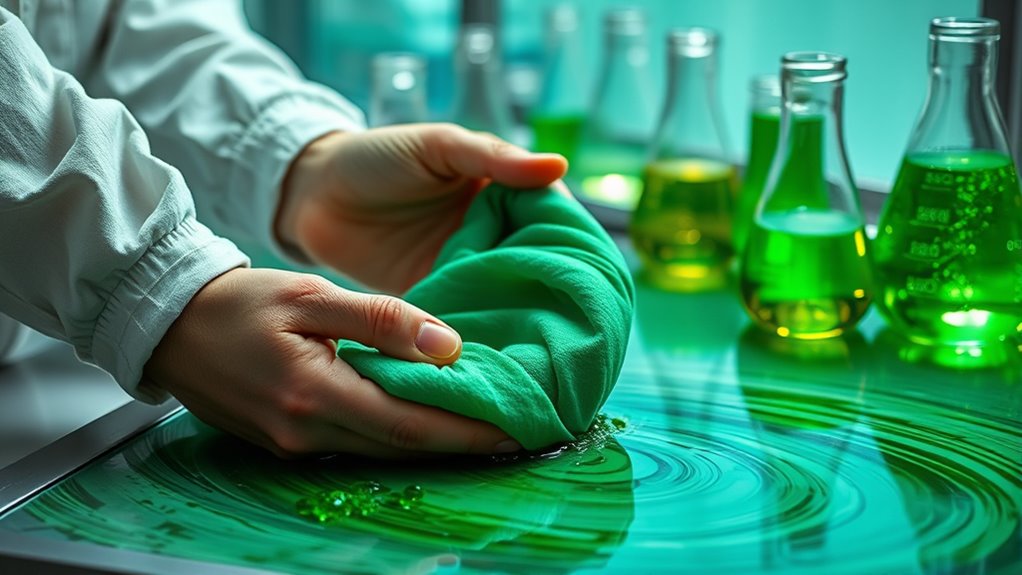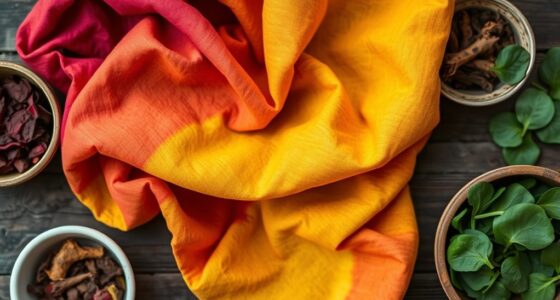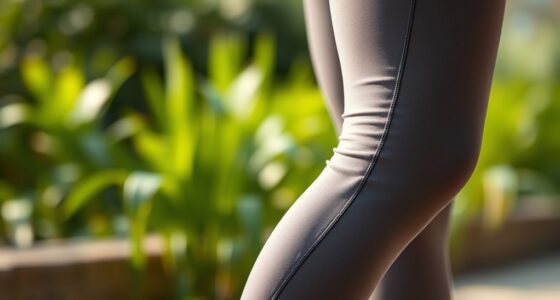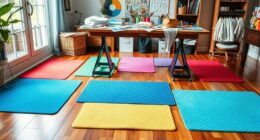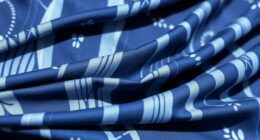Algae dye labs provide a sustainable, chemical-free way to color fabric by using natural pigments from algae like phycocyanin and carotenoids. This eco-friendly process reduces pollution, conserves water, and produces biodegradable dyes that are safe for the environment. It’s gaining popularity in industries like fashion and textiles, proving that vibrant, durable colors can come without toxic chemicals. If you want to know more about how algae dyes are transforming sustainable business practices, keep exploring.
Key Takeaways
- Algae dye labs produce eco-friendly, non-toxic dyes from algae pigments like phycocyanin and carotenoids.
- The process uses sustainable cultivation methods, minimizing water, energy, and chemical waste.
- Algae dyes are biodegradable, reducing environmental pollution and promoting a greener textile industry.
- These labs cater to fashion, art, and home textiles, offering vibrant colors without harmful chemicals.
- The industry is growing due to consumer demand for sustainable, chemical-free dyeing solutions.
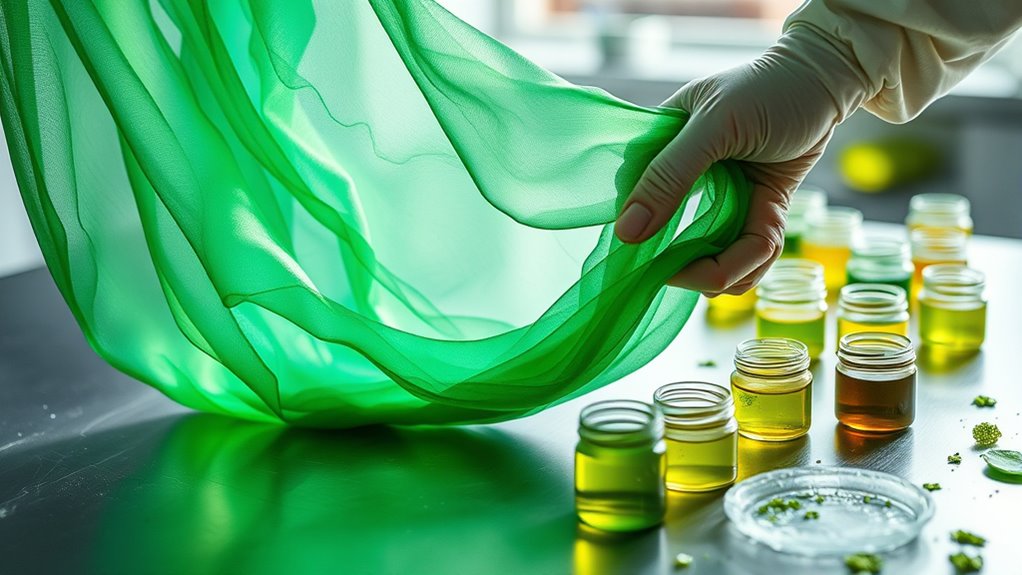
Have you ever wondered how sustainable dyes are made? If you’re curious about eco-friendly ways to color fabrics, algae dye labs are revolutionizing the industry. These labs focus on sustainable practices, guaranteeing that dye production doesn’t harm the environment or human health. Instead of relying on traditional chemical dyes that often contain toxic substances, algae cultivation offers a natural alternative that’s both beautiful and eco-conscious. By harnessing algae’s natural pigmentation, these labs create vibrant dyes without the harmful chemicals found in conventional dyes. This approach not only reduces pollution but also minimizes water usage and energy consumption, making it a genuinely sustainable process.
The process begins with cultivating algae in controlled environments—either in large-scale outdoor ponds or indoor bioreactors. These algae are selected for their ability to produce colorful pigments, such as phycocyanin (blue), carotenoids (orange and yellow), or chlorophyll (green). When the algae reach maturity, they are harvested and processed to extract their natural pigments. This step is vital because it guarantees that the dyes are pure, vibrant, and free from synthetic additives. The entire algae cultivation process emphasizes sustainability; it often uses minimal water, harnesses renewable energy sources, and employs waste management practices that prevent environmental contamination. Additionally, ongoing research and innovation in biotechnology are helping to improve the efficiency and variety of algae-derived dyes.
Algae are cultivated sustainably using minimal water, renewable energy, and eco-friendly waste management practices.
Once extracted, the pigments are refined into dyes that can be applied to textiles. Because these dyes are derived from living organisms, their production cycle is relatively low-impact, especially compared to chemical dye manufacturing. Plus, algae-based dyes are biodegradable, breaking down naturally once disposed of, which helps reduce long-term environmental footprint. You’ll find that these dyes are versatile, offering a wide range of colors that can be used in fashion, home textiles, and art projects. The vibrant hues achieved through algae cultivation demonstrate that eco-friendly doesn’t mean dull or limited—these dyes deliver rich, lasting colors.
As more designers and manufacturers adopt algae dyes, the industry is shifting toward more sustainable practices. This shift is driven by consumer demand for greener products and by growing awareness of the environmental costs of traditional dyeing processes. Algae dye labs continue to innovate, exploring new strains of algae and refining extraction techniques to enhance colorfastness and vibrancy. By choosing products colored with algae-based dyes, you’re supporting a cycle of sustainable practices that reduce reliance on toxic chemicals, conserve water, and promote renewable resources. It’s a simple choice that makes a significant impact, helping to create a more sustainable future for fashion and textiles.
Frequently Asked Questions
What Inspired Algae Dye Labs to Focus on Sustainable Dyes?
You’re curious about what inspired algae dye labs to focus on sustainable dyes. They’re driven by a passion for eco-friendly innovation and a desire to reduce environmental impact. Seeing how traditional dyeing harms ecosystems, they decided to develop algae-based dyes that are safe and sustainable. Their goal is to create beautiful colors without toxic chemicals, making a positive difference for the planet while inspiring others to adopt environmentally conscious practices.
How Does Algae Dye Compare to Traditional Synthetic Dyes?
You’ll find that algae dye offers a great eco-friendly alternative to traditional synthetic dyes, which often contain toxic chemicals. Algae dyes are natural, renewable, and biodegradable, making them better for the environment. Plus, they tend to have good dye longevity, ensuring your fabrics stay vibrant longer. Compared to synthetic options, algae dyes reduce pollution and support sustainable practices, making them a smart choice for eco-conscious consumers who want durable, environmentally friendly clothing.
What Are the Challenges of Scaling Algae Dye Production?
Scaling algae dye production presents challenges like scaling manufacturing efficiently and establishing a reliable supply chain. You’ll need to optimize cultivation processes and guarantee consistent quality, which can be complex at larger volumes. Additionally, sourcing raw materials and managing logistics require careful planning to meet demand without disrupting sustainability goals. Addressing these issues is vital for making algae dye a viable, eco-friendly alternative on a broader commercial scale.
Can Algae Dyes Be Used on All Types of Fabrics?
You might wonder if algae dyes work on all fabrics. While they’re versatile, fabric compatibility varies; some materials like natural fibers—cotton, linen, silk—absorb algae dyes well, providing vibrant colors. However, synthetic fabrics like polyester may not bond as effectively, affecting color retention. To guarantee the best results, test algae dyes on different fabrics first, considering their specific properties for ideal coloring and long-lasting vibrancy.
Are Algae Dyes Suitable for Sensitive or Allergy-Prone Skin?
Did you know that around 15% of people experience skin sensitivities or allergies? When it comes to algae dyes, they’re generally considered allergy-safe because they’re natural and free of synthetic chemicals. If you have sensitive or allergy-prone skin, algae dyes are a good choice, as they minimize irritation. However, always test a small patch first to guarantee allergy safety and avoid any adverse reactions.
Conclusion
By choosing algae dye labs, you’re jumping on the bandwagon of eco-friendly fashion, proving that you don’t have to sacrifice style for sustainability. Their innovative approach shows that you don’t have to reinvent the wheel to make a difference. So, when you pick garments dyed with algae, you’re not just making a statement—you’re setting the stage for a greener future. Remember, a little effort goes a long way, and every choice counts.

